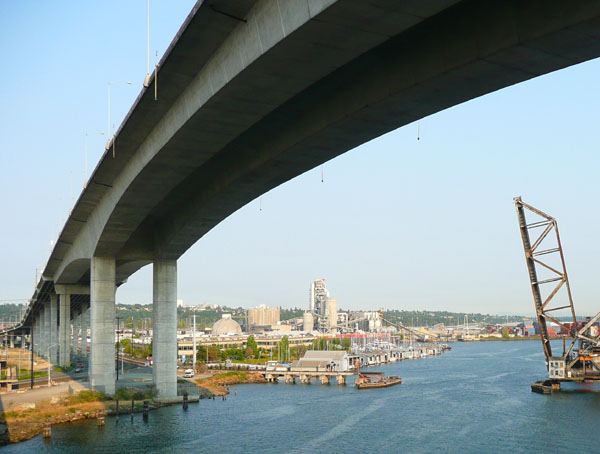Bringing Better Transit To The West Side

[ The West Seattle Bridge ]
(Editor’s note: In the comments on Cary Moon’s tunnel post there was much discussion about options for transit service and McGinn’s proposal for light rail to West Seattle, and Joel Horn, former executive director of the Seattle Monorail Project, was asked to weigh in these questions: So what options ARE technically viable for better mass transit to the west side? And what would have to change politically for transit that requires taking a car lane to succeed—like a true BRT system or light-rail?)
First off, I want to start by acknowledging that many good folks have worked on this for quite a few years. And this isn’t the venue for a voluminous thesis, but there are a few points that I will make to continue the discussion:
1)Â The quickest and least expensive way to add high capacity transit to West Seattle is to use the West Seattle Bridge (WSB). The Seattle Monorail Project (SMP) worked with a number of the world’s best engineers and construction companies, and with the City engineers, to determine the load carrying capacity of the WSB. SMP also worked with SDOT and had many public workshops about how to add high capacity transit and not remove any traffic lanes. The best way to achieve that is to use the airspace above the bridge. This airspace is a public resource that has significant capacity for grade-separated transit. There was a limitation as to how much weight can be added to the WSB. I do not know if it could handle the weight of an elevated light rail solution similar to the elevated system that Sound Transit is using to go to the airport.
2)Â When SMP was coordinating its construction schedule with other major projects downtown we were instructed that Sound Transit would get first priority to complete light rail in the 3rd Avenue bus tunnel. Then the Green Line would be built on 2nd Avenue and then the viaduct would be taken down. SMP ran their ridership model to determine the potential impact on the Green Line during the period that the viaduct was not available. The model showed that SMP would need to add 4 additional trains to the Green Line to accommodate the additional ridership (running every 6 minutes to West Seattle). One of the relevant pieces of information from this ridership analysis was how many people would give up their cars and switch to the Monorail. The question was what would happen when the car capacity was replaced. At the time ridership experts advised the SMP that much of the ridership would permanently switch to mass transit, thereby reducing the need for capacity replacement with the viaduct project.
3)Â One additional piece of information that came out of the ridership studies was that there is excess capacity on the downtown streets today. This is easy to observe if you go downtown on a “normal” day i.e. no construction and no Mariners game. The street system works well and can absorb additional demand for travel. In fact, even though the Monorail Green Line would have taken out a lane on 2nd Avenue there was still adequate capacity to handle the existing load. Ridership studies involve many variables and can be manipulated to make an argument for one alternative or another, but it was clear during the SMP analysis that taking a lane out of 2nd Avenue would not have an adverse impact on Downtown traffic if the lane was used for a transit solution that would actually be competitive enough (time savings by using grade separated transit and money saved by not needing to pay for parking) to get people to give up their car.
There are many additional topics to add to the mix, and these are only starting points to consider when thinking about how to best serve West Seattle with transit.
